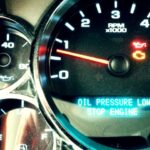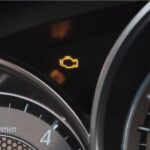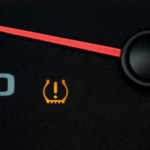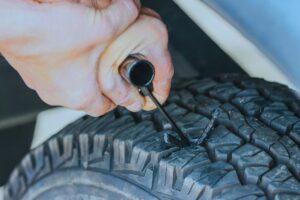It can be quite concerning to have the tire pressure light turn on while you are driving. But you checked the tires, and they all seem to be okay. If the low tire pressure light is on, but tires are fine, what’s the problem?
There are times when tires have the right pressure, and yet the low tire pressure light will still turn on. The best thing to do is manually check each tire to confirm that they have the right tire pressure. Then reset the TPMS (tire pressure monitoring system) and see if that gets rid of the warning light on your dashboard.
If all the tires are inflated to the right tire pressure, but the tire pressure warning light still turns on, there could be a leak in one of the tires. It is also possible that your car’s TPMS is malfunctioning. If there’s a leak in any of your tires, use your tire gauge to check their individual tire pressure.
Read on to learn more about why the tire pressure warning light turns on even if all the tires seem to be ok, the reasons for this, and how you can fix this problem.
Low Tire Pressure Light On but Tires Are Fine

Manually Check Tire Pressure
Why is my tire pressure light on when my tires are fine? When the ‘low tire pressure’ warning light turns on, and all your tires seem to be okay, there is something wrong somewhere. First, manually check the tire pressure on each tire. You can use a tire pressure gauge to do this.
Reset TPMS
After checking the tires, and finding that your tires are all right pressure level, just reset the TPMS (tire pressure monitoring system). Observe whether the warning light goes off. If the warning light still turns on, check for a tire leak. Or you may have a faulty TPMS.
If TPMS Flashes, Remove the Tire, Then Re-Install
If the TPMS light flashes each time you start your car, it could be that a tire has been improperly replaced. To correct the problem, remove the tire from the wheel and re-install it properly. If this is the only problem, the warning light will turn off.
It is not safe to drive with this warning light illuminated. Several things could trigger this ‘warning light.’ So, you need to check further to know the actual cause. Driving with the tire pressure monitoring system light on is dangerous. You can cause a tire blowout which could endanger you and other drivers on the road.
Drive to the Nearest Tire Service if the Light Comes On
If the light flashed while driving, you need to slow down and drive to the nearest tire service center or gas station to have your tires or your TPMS checked. The least you need to do is to stop on the road shoulder and check the tires.
Checking a Faulty Tire Pressure Monitoring System
If you know that all your tires are okay and the tire pressure warning lights keep on turning on, it could be a problem with the Tire Pressure Monitoring System (TPMS). You need to check if it is still working. Here’s how you can diagnose if it’s going bad or not.
There are two things you can do to correct this problem:
- Reset the TPMS by pressing its button and see what happens, or
- Replace the TPMS sensors that are damaged
But before doing anything, it is best if you could confirm what exactly causes the problem. Here’s what you need to do:
1. Take Your Car for a Short Drive
Start the engine and try to go for a short drive. The low tire pressure warning light should turn on for a few seconds after starting the engine. If there’s nothing wrong with the system, the light should turn off shortly.
But if this warning light stays on, drive your car to the nearest tire shop or gas station. Have them check your tires’ pressure.
In many cases, tires that don’t have 90-85% air pressure trigger this warning light. Icy or cold weather tends to reduce the air pressure inside the tires. So, you need to take your car for a short drive to heat the insides of the tires. This way, the pressure can also increase.
However, if all the tires are warmed up and are inflated correctly, but the low warning light still does not go off, do the next step.
2. Reset the Tire Pressure Monitoring System
Consult your car’s operator’s manual on resetting the Tire Pressure Monitoring System (TPMS). The location of the TPMS reset button depends on your car’s make and model. It is commonly located on the instrument panel or inside the glove box.
Once you have located the TPMS button, do the following things:
- Turn the ignition key to the ON position but don’t start the engine;
- Press and hold the tire pressure monitoring system reset button for about three seconds and then release it. You’ll hear a beep from the system. After you hear this audible warning, turn off the warning light;
- Start the engine and drive your car. Maintain a speed of not less than 19 miles per hour (mph) for about 30 minutes to one hour. This will complete the reset procedure;
- If the low warning light of the TPMS turns on again, it could be a problem with the TPMS sensors. You need to have them checked or replaced; and
- Take your car to the car dealer if it is still under warranty or a car tire center for the checking and repairing of the TPMS or replacement of the TPMS sensors.
3. Other Options for Resetting the Tire Pressure Monitoring System
There are two other options for resetting the TPMS of your vehicle. They are more time-consuming and more involved. That’s why they are better suited to professional car mechanics.
- With the engine turned off, open the hood and remove the positive battery cable from its post. Next, turn the ignition key to “ON.” Then, push the horn button for around three seconds. This will discharge any power that remains in the car. Then reconnect the battery.
- Inflate each tire to three psi (pounds per square inch) more than the recommended level. Then deflate the tires completely. Include your spare tire in this process. After the tires are deflated completely, re-inflate them to the correct PSI.
Additional Tips for Low Tire Pressure Light On but Tires Are Fine

1. Don’t Reset TPMS Every Time the Warning Light Turns On
If your car has a TPMS, don’t practice the habit of resetting it every time the low tire pressure warning light turns on. The purpose of this system is to safeguard your life as well as the lives of your passengers.
2. Check Tire Pressure Regularly
Make the most of the TPMS and do your part. What is your part? It is to check the tire pressure on all four tires each time you plan to drive your car. Don’t just rely on the TPMS to monitor and check the tire pressure. At the very least, you should visually inspect your tires before driving on.
3. Keep a Simple Tire Pressure Gauge Inside Your Glove Box
The best thing you can do is to keep a simple tire pressure gauge inside your glove box. Before inserting the ignition key on its slot, visually inspect the tires. But if you can physically insert the tire pressure gauge on the air valve of each tire to see if they are on the right pressure level, that would be the best.
Again, why is the low tire pressure light on, but the tires are fine? There are times when your car’s low tire pressure light will turn on even if the tires are fine. The best recourse for this issue is to manually check the pressure of all tires to confirm the problem. After this, reset the TPMS to get rid of the low tire pressure light on the dash.
The Value of the Tire Pressure Monitoring System
What’s the importance of the tire pressure monitoring system? It is essential because not many drivers practice checking the pressure levels of the tires of the vehicle they are going to drive for that day. Most drivers turn on the engine and drive away.
So, I’d like to ask you a question. When was the last time you checked the tire pressure on the tires of your car? Carmakers recommend that car owners check the tire pressure at least once a month. And yet, even this too far-in-between checking frequency is not being followed by most drivers.
The result: nearly 200 deaths happen every year from car crashes that could have been prevented if the tires are checked, and the vehicles are not overloaded. That deathly figure should tell you how important the TPMS is in your car. It makes you aware that you are driving on underinflated tires, and this is dangerous.
How the Tire Pressure Monitoring System Works
The tire pressure monitoring system is composed of pressure sensors and a digital receiver. Pressure sensors in a typical TPMS are small electronic boxes that are mounted on each of the wheels. These sensors are continuously monitoring the pressure inside the tires in real-time.
Two Types of Tire Pressure Monitoring System
There are two types of tire pressure monitoring systems:
Indirect TPMS
This type is integrated into the Anti-Lock Brakes or ABS of the car. It has a wheel speed sensor that detects slow rotation speeds when the tire is losing pressure. The differences in pressure levels are detected by the CPU of the car, which then turns the warning light on.
Direct TPMS
This type utilizes sensors on every wheel to measure the tire pressure on a car’s four corners. Some TPMS models have sensors on the tire valves. If the system detects low tire pressure, it sends the information to an inboard receiver. This causes the low tire pressure warning light to turn on.
Some believe that the indirect system is the better of the two. The sensors of the direct TPMS are susceptible to damage and wear. These sensors can malfunction if the wheel accidentally drops in a large pothole. They could also suffer damage when the tires are being replaced or serviced.
On the other hand, indirect TPMS tends to require fewer resets over the life of a car. In many cases, there are no other things that the driver needs to do. This system works flawlessly each time you push the start button or turn your vehicle’s ignition key.
Importance of Having the Correct Tire Pressure
What Happens If You Drive with Underinflated Tires?
The only parts of your car that gets in contact with the road are its tires. Tires can be underinflated or overinflated. Driving with underinflated tires is the primary cause of tire failure. If the pressure inside the tire is too low, there will be too much contact between the tire and the road.
That means a larger surface area of the tire is constantly rolling on the ground than what was designed. So, there is higher friction, which creates too much heat inside the tire. Heat increases the rate of tread wear. More seriously, it can lead to a tire blowout or tire tread separation.
What Happens If You Drive with Overinflated Tires?
Premature wear of the tires is the result of driving with overinflated tires. You will also experience a stiff ride if your tires are overinflated. But the thing is: the TPMS warning light will not be triggered by overinflated tires.
You can drive your car for many miles with overinflated tires causing considerable tire wear without knowing it. So, you really need to check the tire inflation before you drive around. A digital tire pressure gauge is the most convenient tool for this purpose.
Amazon Products That Ensure Correct Tire PSI

Here are tire-related products that can assist you in correctly inflating your tires with the correct psi. They are all available at Amazon.com:
1. AstroAI Digital Tire Pressure Gauge 150 PSI 4 Settings
Click here to see it on Amazon.
This product can help you inflate your tires with the right psi every time. The AstroAI Digital Tire Pressure Gauge is a digital pressure gauge that is very easy to use. It has a backlit display, so you can easily see the digital reading even in dimly lit areas. It has a lighted nozzle that instantly forms a seal so no air can escape while inflating the tire.
2. VacLife Tire Inflator Portable Air Compressor
Click here to see it on Amazon.
The VacLife Tire Inflator Portable Air Compressor is a reliable and efficient solution for quick and easy tire inflation. Boasting fast inflating capabilities and simple operation, this auto tire air compressor can inflate standard car tires in a matter of seconds.
Its plug-and-play design allows users to conveniently connect it to the 12V power outlet in their car and attach the stem to the tire valve. With a simple press, the car air compressor takes care of the rest, making it an excellent emergency solution for on-the-go inflation needs.
One of the standout features of the VacLife Tire Inflator is its auto shut-off functionality, combining simplicity with enhanced safety.
Users can preset the desired pressure level before starting the inflation process. Once the desired level is reached, the car air compressor will automatically shut off, eliminating the risk of over-inflating and providing users with peace of mind during tire maintenance.
3. DEWALT 20V MAX Tire Inflator
Click here to see it on Amazon.
The DEWALT 20V MAX Tire Inflator stands out as a versatile and powerful tool for maintaining optimal tire pressure on the go.
Designed for convenience and efficiency, this air compressor tire inflator comes equipped with a high-pressure inflation mode featuring automatic shutoff, ensuring precise and accurate tire inflation without the risk of overinflating.
This is particularly beneficial for maintaining the correct tire pressure, which contributes to better fuel efficiency, tire longevity, and overall vehicle performance.
In addition to its high-pressure inflation mode, the digital tire inflator offers high-volume inflation and deflation modes, providing flexibility for various inflation needs. Whether it’s quickly inflating a tire or efficiently deflating one, this tool caters to a range of applications.
Conclusion: Low Tire Pressure Light On But Tires Are Fine
There will be times when the tire pressure light will turn on even if the tires are okay. The best way to solve this problem is to manually check each tire to see if they all have the correct tire pressure. Once you have done that, just reset the TPMS. That should turn off the tire pressure warning light. If not, a professional mechanic will have to assess if there are other issues with the car.
Related reading:
Screw in Tire (Leak or No Leak) – What to Do?
Nail in Tire [How to Repair? What to Do?]










![Tire Pressure Sensor Fault [Causes and How to Fix] tire pressure sensor fault](https://roadsumo.com/wp-content/uploads/2021/09/tire-pressure-sensor-fault-150x150.jpg)

![Read more about the article Walmart Tire Rotation Cost [What Does Walmart Charge?]](https://roadsumo.com/wp-content/uploads/2021/07/walmart-tire-rotation-cost-300x200.jpg)
